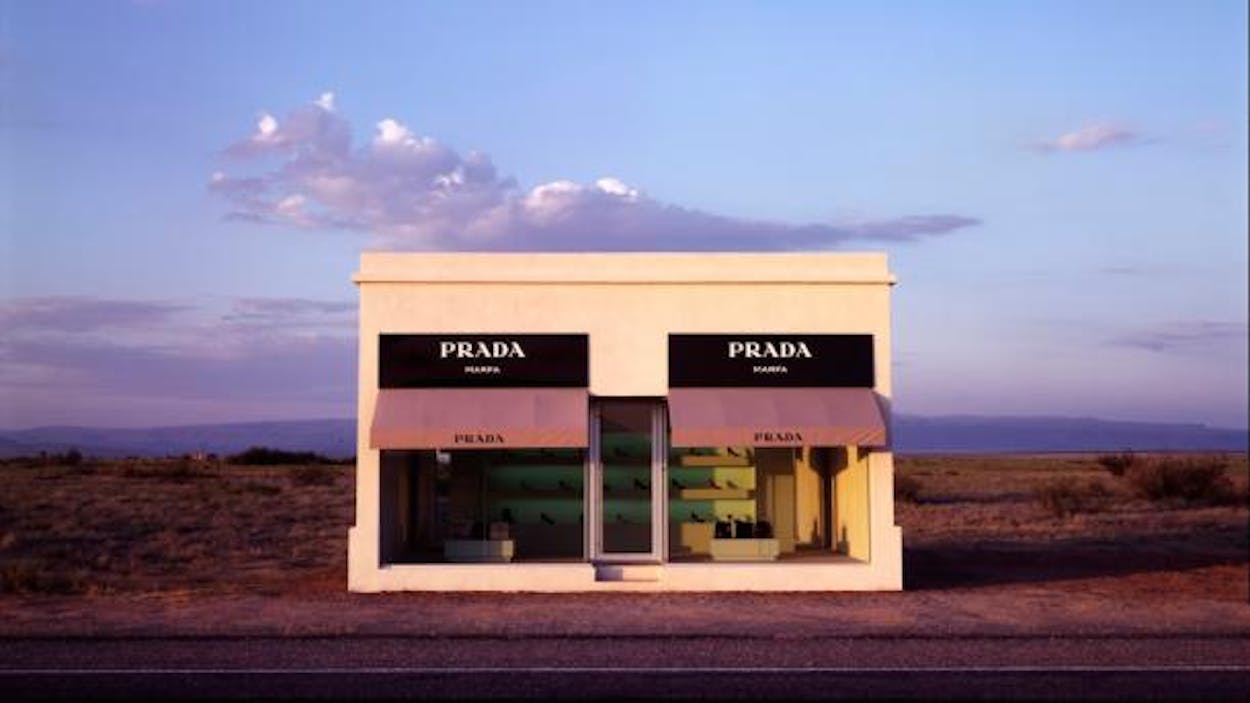After the Texas Department of Transportation ordered the removal of Playboy Marfa on the grounds that it was illegal advertising, we learned that the government agency had classified nearby Prada Marfa as illegal advertising too. (Read more about the revealing art-versus-advertising debate in Marfa here.) On September 10, 2013, we reached Michael Elmgreen, one of the two artists behind Prada Marfa, for comment:
MICHAEL ELMGREEN: This is an embarrassment for that office. If it really is against the regulations, they should have found out in 2005, when Prada Marfa was erected. If I were head of the office there, I would fire the person who came up with this now, after almost ten years. This is a waste of taxpayer money.
There’s no company behind the artwork. I was not commissioned by Prada. I asked them permission to use their logo because I didn’t want a lawsuit. They never, ever asked me to do advertisement for them. This work is not to promote their brand. Maybe today it has become so famous that it is actually good for them to have it there, but it was meant as a critique of the luxury goods industry, to put a shop in the middle of the desert. Prada was sympathetic to the idea of being criticized, and that’s all. There’s no commercial relation between Prada and us.
If they [TxDOT] want to go to court, I will be able to teach them a long lesson in art history, because there is a lot of artwork throughout history that would be banned on that account. Most famous contemporary artists today have been using, at some point in their careers, a brand and have played it off against a different context, displayed it in a different and new way—sometimes as statements against consumerism. They’re not only slow but they also seem to be a bit uncultured. If they read the books we all should have read in school—if we didn’t sleep in classes—then they would know about these things.
FRANCESCA MARI: In addition to Andy Warhol, what other artists have employed logos in their art?
ME: Plenty of famous artists for the past fifty years have used brand logos, like Campbell Soup or Coca Cola, in their artworks as cultural references—from Warhol to Ai Wei Wei. If these were ads, I doubt that art collectors would be willing to pay millions of dollars for these works on auctions, like they pay for an Andy Warhol painting, for instance.
Are you not allowed to include references to reality? What TxDOT is saying is that you’re not allowed to quote anything but art in your artwork. I mean, will you not be able to do artworks with the Statue of Liberty? Would you not be able to do artworks with the dollar sign? Would you not be able to do artworks that were using figures from public culture, like the Disney figures? Would you not be able to use Coca Cola signs? It’s very square-minded.
It’s an interesting discussion, maybe. But I’m quite sure they wouldn’t win it, since we were never, ever commissioned to do a promotion for Prada. Prada Marfa is an artwork that has been initiated by us [and Ballroom Marfa] and Art Production Fund in New York.
There’s a difference between being commissioned by a company to do something for them and using their logo, and using their logo on your own. I’m not saying that it’s justified to ban the Playboy sign, but it’s a very different story that Playboy hired an artist to do something with their logo than an artist using a brand logo—because I’m not speaking on behalf of Prada.
FM: Given that they determined this on July 9, and they haven’t taken any action—there’s no official Order of Removal—I suspect that they’re having their own internal debates about the situation. Have you received any notices?
ME: No. With all the skepticism when it first was installed, I think it might have become part of the Marfa profile, as a modest little entity. I think a lot of people would actually be unhappy that Prada Marfa was not there. If they want to remove it because of bureaucracy, we tear it down. And then we can say that one of the quite well-known permanent artworks—that hasn’t cost taxpayers anything and that has been elected one of the most-worth-seeing roadside attractions in the states—is no longer.
But they can’t argue that it’s an advertisement. They can, of course, argue that the Prada logo is on it, but these two things are not the same. An ad is not where a brand logo appears. Then graffiti or someone writing Prada on his T-shirt would be an advertisement. It’s not. An advertisement is something a company places in order to promote itself. TxDOT just wants a house without a logo. That is the essential distinction between the Playboy and the artwork by us, I think.








